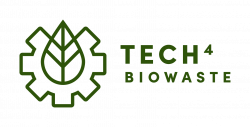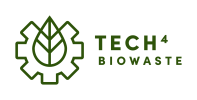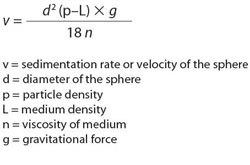Centrifugation
| Technology | |

| |
| Technology details | |
| Name: | Centrifugation |
| Category: | Pre-processing (Separation technologies), Post-processing (Separation technologies) |
| Feedstock: | All materials |
| Product: | Separated products |
Centrifugation is a mechanical separation process which involves the use of the centrifugal force to separate particles from a solution or liquids of different densities according to particle size, shape, density, viscosity and rotor speed. The more dense components of the mixture migrate away from the axis of the centrifuge, while the less dense components of the mixture migrate towards the axis. Next to the separation of solids from liquid, it is possible to obtain separation between two liquids of different densities as well, given that the density difference is large enough.
Feedstock
Origin and composition
The centrifugation method is used to separate two miscible substances. The most common application is the separation of solids from highly concentrated suspensions, which is used in the treatment of sewage sludges for dewatering where less consistent sediment is produced. In the food industries, special centrifuges can process a continuous stream of particle-laden liquid.
Pre-treatment
For a centrifugation, in general no specific pre-treatment is needed since it is used to separate different fractions within a process chain. Sometimes it is combined with other separation technologies like filtration.
Process and technologies
There is a correlation between the size and density of a particle and the speed at which the particle separates from a heterogeneous mixture, when the only force applied is gravity. The larger the size and the larger the density of the particles, the faster they separate from the mixture. By applying a larger effective gravitational force to the mixture, like a centrifuge does, the separation of the particles is accelerated. This way, in industrial and lab settings, particles that would naturally separate over a long period of time can be separated much faster.
The centrifugation speed is specified by the angular velocity, usually expressed as revolutions per minute (rpm), or acceleration expressed as g. The conversion factor between rpm and g depends on the radius of the centrifuge rotor. The particles' settling velocity in centrifugation is a function of their size and shape, centrifugal acceleration, the volume fraction of solids present, the density difference between the particle and the liquid, and the viscosity.
The sedimentation of particles can be explained by Stoke's law. The equation can be used to calculate the velocity of sedimentation based on five parameters:
From the Stokes equation, five important behaviours of particles can be explained:
- The rate of particle sedimentation is proportional to the particle size
- The sedimentation rate is proportional to the difference in density between the particle and the medium.
- The sedimentation rate is zero when the particle density is the same as the medium density.
- The sedimentation rate decreases as the medium viscosity increases.
- The sedimentation rate increases as the gravitational force increases.
Disc-stack centrifugation
Disc-stack centrifugation is used for removing suspended solids from a liquid having a lower specific gravity than the solids. The solids content of the feed is usually in the range of 0.1-10 V/V%.
Basket centrifugation
Basket centrifuges are often called centrifugal filters or clarifiers. The basket centrifuge uses centrifugal force to generate a pressure which forces the liquid through the caked solids, the filter cloth, the backing screen, and finally the basket perforations. The filter cloth retains the solid particles inside the rotating basket while the permeating liquid is continuously discharged.
Solid bowl centrifugation
The Solid Bowl centrifugation principle is schematically shown in the picture on the right. "Solid bowl centrifuges (SBCs), also known as decanter centrifuges, are widely used for various solid-liquid separation tasks, owing to its high-efficiency, small machine footprint and good continuity in production. In the SBC, once the slurry is fed through the centre-positioned feed pipe, solids can rapidly settle onto the drum wall and these settled solids are further dewatered on the conical section of the SBC before being discharged from the product chute. The clarified liquid, so-called effluent, overflows through the bowl weir."[1]
Products
The remaining liquid is called supernatant or supernate. The solids or pellets and the supernatant can be the final product or can be further processed.
Post-treatment
The post-treatment of the precipitate and/or the supernatant is depending on the next steps within the production chain. A typical next step is to dry the solids for further processing.
Technology providers
| Company name | Country | Technology subcategory | Technology name | TRL | Capacity [L/h] | Processable volume [L] | Relative centrifugal force [g] | Feedstock: Food waste | Feedstock: Garden & park waste |
|---|---|---|---|---|---|---|---|---|---|
| Alfa Laval | Sweden | - | AlfaPure S2-S7 | - | 900-7000 | - | - | ● | ● |
| Alfa Laval | Sweden | - | Alfie 200 | 230-280 | - | - | ● | ● | |
| Ecofast | Italy | - | DeHydra SC1B | - | 300 | - | - | ● | ● |
| Flottweg | Germany | - | SEDICANTERS® S6E-3 | - | 50000 | - | 5000 | ● | ● |
| Imperial Machine Company Ltd. (IMC) | United Kingdom | - | - | - | 700 | - | - | ● | ● |
| Rendisk | The Netherlands | - | - | - | 450 | - | - | ● | ● |
| Tidy Planet | United Kingdom | - | DeHydra Super Compact | 9 | 700 | - | - | ● | ● |
Alfa Laval
| General information | |||
| Company: | Alfa Laval Corporate AB | 
| |
| Country: | Sweden | ||
| Contact: | |||
| Webpage: | https://www.alfalaval.com | ||
| Technology and process details | |||
| Technology name: | AlfaPure | Technology category: | Pre-processing (Separation technologies), Post-processing (Separation technologies) |
| TRL: | commercial | Capacity: | 900-2000, 600-3000, 5000–7000 l·h-1 |
| Processable volume: | L | Relative centrifugal force: | g |
| Rotor type: | Temperature: | 0-80 (15-100) °C | |
| Other: | |||
| Feedstock and product details | |||
| Feedstock: | water and oil-based liquids | Product: | seperated fractions |
Alfa Laval is a leading global provider of first-rate products in the areas of heat transfer, separation and fluid handling. With these as its base, Alfa Laval aims to help enhance the productivity and competitiveness of its customers in various industries throughout the world. We define their challenges and deliver sustainable products and solutions that meet their requirements – mainly in energy, the environment, food and the marine industry.
Alfa Laval
| General information | |||
| Company: | Alfa Laval Corporate AB | 
| |
| Country: | Sweden | ||
| Contact: | |||
| Webpage: | https://www.alfalaval.com | ||
| Technology and process details | |||
| Technology name: | Alfie | Technology category: | Pre-processing (Separation technologies), Post-processing (Separation technologies) |
| TRL: | commercial | Capacity: | 230-280 l·h-1 |
| Processable volume: | L | Relative centrifugal force: | g |
| Rotor type: | Temperature: | 5–50 °C | |
| Other: | |||
| Feedstock and product details | |||
| Feedstock: | from water-based industrial fluids, coolants | Product: | seperated / cleaned fractions |
Alfa Laval is a leading global provider of first-rate products in the areas of heat transfer, separation and fluid handling. With these as its base, Alfa Laval aims to help enhance the productivity and competitiveness of its customers in various industries throughout the world. We define their challenges and deliver sustainable products and solutions that meet their requirements – mainly in energy, the environment, food and the marine industry.
Alfie is a simple to use separator: Turnkey, portable, small footprint, centrifugal disc stack separators that remove contaminating oil, grease and solid particles from water-based industrial fluids such as coolants and wash liquids.
Ecofast
| General information | |||
| Company: | Ecofast Italia S.r.l. | 
| |
| Country: | Italy | ||
| Contact: | |||
| Webpage: | www.ecofast.eu | ||
| Technology and process details | |||
| Technology name: | DeHydra SC1B | Technology category: | Pre-processing (Separation technologies), Post-processing (Separation technologies) |
| TRL: | Capacity: | 300 kg/h l·h-1 | |
| Processable volume: | L | Relative centrifugal force: | 930 rpm g |
| Rotor type: | Pump rotor | Temperature: | °C |
| Other: | |||
| Feedstock and product details | |||
| Feedstock: | Food waste | Product: | De-watered food waste |
Ecofast Italia is an innovative SME that designs and manufactures equipment to compact food waste in professional catering and catering. The use of our machines makes the kitchen more hygienic and clean and helps to improve the safety of the working environment. Less waste to be disposed of, less waste in landfills, less greenhouse gases produced for their collection.
From the beginning, the company’s activity has been characterized by a more marked technical connotation, carrying out, first in Italy, not only important tests in the use of food waste disposes, but an innovative research and development activity to the invention of new patents for new products/technologies in order to enhance a more sustainable and economic management of food waste. Ecofast Italia S.r.l. – Environmental Technology was established in Milan on November 23th 1998, at first to import and distribute food waste disposers for domestic and professional users, in Europe.
The DEHYDRA SC1 can be placed in the washing area or in cleaning areas of canteens and/or restaurants where it is required to dispose of up to 150 kgs per hour of food waste. Our compact food waste reduction machine is a stainless steel standalone de-watering solution, made up of a hydro extractor, and a centrifugal press which separates the liquid from the solid component. The DeHydra dewater apparatus is the only self-cleaning de-watering system that can be fitted with wastewater re-circulation.
Flottweg
| General information | |||
| Company: | Flottweg SE | 
| |
| Country: | Germany | ||
| Contact: | |||
| Webpage: | https://www.flottweg.com/ | ||
| Technology and process details | |||
| Technology name: | SEDICANTERS® S6E-3 | Technology category: | Pre-processing (Separation technologies), Post-processing (Separation technologies) |
| TRL: | Capacity: | 25 - 40 Mt/h l·h-1 | |
| Processable volume: | Up to 50 m3/h L | Relative centrifugal force: | 3650 rpm, 5000 x g g |
| Rotor type: | Flottweg Simp Drive® | Temperature: | Up to 100 °C |
| Other: | |||
| Feedstock and product details | |||
| Feedstock: | Biomass, yeast suspensions, protein suspensions, fermentation broths etc. | Product: | Clarification, dewatering, thickening of sludge, separation of three-phase mixtures, classification of solids, sorting of solids by density |
Flottweg has their headquarters in Vilsbiburg, Germany and has been manufacturing centrifuges, belt presses, and processing systems for mechanical solid-liquid separation for more than 60 years. This technology encompasses core functions in many industrial sectors, i.e. clarifying liquids, separating liquid suspensions and concentrating and dewatering solids. Our company has grown to more than 750 employees and we achieve sales of 152 Million Euro, with an export rate of more than 85 %.
Flottweg Sedicanters® are used for the continuous separation of fine solids from liquids with the solids forming a soft to flowing sediment. Flottweg Sedicanters® are preferably used in cases where the solids are too fine to be effectively processed in a decanter and the sediment cannot be easily discharged from the decanter due to its soft consistency. Flottweg’s range of Sedicanter® sizes includes machines with capacities up to 50 m3 /h (220 gallons per minute).
Imperial Machine Company Ltd. (IMC)
| General information | |||
| Company: | Imperial Machine Company Ltd. (IMC) | 
| |
| Country: | United Kingdom | ||
| Contact: | |||
| Webpage: | https://www.lincat.co.uk/index.php?p=brands/imc | ||
| Technology and process details | |||
| Technology name: | Technology category: | Pre-processing (Separation technologies), Post-processing (Separation technologies) | |
| TRL: | Capacity: | 700 kg/h l·h-1 | |
| Processable volume: | L | Relative centrifugal force: | g |
| Rotor type: | Temperature: | °C | |
| Other: | |||
| Feedstock and product details | |||
| Feedstock: | Soft waste (plate waste, vegetable peelings, meet and fish scraps), medium waste (small pork and chicken bones, vegetables and fruit), tough waste (all red meat bones, cauliflower stalks and fish skins). | Product: | Dewatered and macerated food waste. |
Imperial Machine Company (IMC) has their headquarters in Lincoln, UK and has been engineering catering solutions for more than 110 years. We have designed, installed and supported catering products for foodservice operations for generations; a fact we at IMC are immensely proud of.
Food waste typically represents around 40% of total commercial catering waste. It is difficult and costly to process and dispose of this efficiently. Of this 40%, approximately 77% is liquid. WasteStation grinds the food waste into fine particles, which are fed directly into a built-in dewatering system, or for where space in the kitchen is limited, a remote dewatering system. Through centrifugal action, excess liquid is forced out. The resulting solid fraction of the food waste is collected in small, easily managed, lidded bins, ready for onward processing.
Rendisk
| General information | |||
| Company: | Rendisk B.V. | 
| |
| Country: | The Netherlands | ||
| Contact: | |||
| Webpage: | https://www.rendisk.com/ | ||
| Technology and process details | |||
| Technology name: | Technology category: | Pre-processing (Separation technologies), Post-processing (Separation technologies) | |
| TRL: | Capacity: | 450 kg/h l·h-1 | |
| Processable volume: | L | Relative centrifugal force: | g |
| Rotor type: | Temperature: | °C | |
| Other: | |||
| Feedstock and product details | |||
| Feedstock: | Food waste | Product: | De-watered food waste |
Founded in Ruurlo, the Netherlands in 1973, Rendisk has grown to become a leader with the brand Rendisk in dishwashing logistics and food waste solutions for professional kitchens in locations around the world. We support kitchen teams with smart logistic solutions for dishwashing and groundbreaking solutions for processing your kitchen waste. All our efforts are focused on making work in the kitchen easier, more efficient and more sustainable. But always with care for the local and world environment most in mind.
The Rendisk Solus Eco is our most compact solution for food waste treatment and can rapidly deal with all kinds of organic food waste. Unique to the Solus Eco is that it’s a standalone unit. Thanks to its innovative technique it has an extremely small footprint and therefore fits in any kitchen or garbage room, but still can reduce your food waste massively.
The Rendisk Solus Eco is a clean and easy to use waste solution for restaurants and business restaurants, universities, hospitals, hotels, maritime areas and locations like holiday and entertainment parks. It’s the perfect food waste solution for anyone who believes in sustainability and efficiency. You simply load the food waste into the hopper. It is then ground and dehydrated using a special centrifugal technique. It’s due to this technique that the Solus Eco can reduce your food waste by up to 80%, lowering your removal cost dramatically. The Rendisk water management system reduces the water consumption considerably comparing with similar systems. Our smart technology reuses the water in the system allowing for a significant reduction in washed water.
Tidy Planet
| General information | |||
| Company: | Tidy Planet Limited | 
| |
| Country: | United Kingdom | ||
| Contact: | Huw Crampton | ||
| Webpage: | https://tidyplanet.co.uk/ | ||
| Technology and process details | |||
| Technology name: | DeHydra Super Compact | Technology category: | Pre-processing (Separation technologies), Post-processing (Separation technologies) |
| TRL: | 9 | Capacity: | 700 kg/h l·h-1 |
| Processable volume: | 700 - 1400 L/h L | Relative centrifugal force: | g |
| Rotor type: | Screw system encapsulated in a stainless steel mesh with 1.5 mm perforations | Temperature: | 5 - 60 °C |
| Other: | |||
| Feedstock and product details | |||
| Feedstock: | Food waste | Product: | Ground and de-watered food waste |
Tidy Planet present the widest range of on-site food waste recycling products on the market, tested and manufactured to the highest quality standards here in the UK – tackling on-site, commercial food waste volumes ranging from 20kg to 20 tonnes of food waste per day.
The Dehydra Food Waste Dewatering system has the capacity to reduce food waste volume by up to 80% and weight by up to 50%, through a process of shredding and then using a centrifuge to separate the liquid wastes, such as sauces, soups and juices. The greatly reduced volume of finely shredded particles of food are captured and deposited into a bin in the footprint of the unit and the weighty liquid effluent disposed to sewer.
Open access pilot and demo facility providers
Patents
Currently no patents have been identified.
References
- Centrifugation in Wikipedia
- Centrifuge in Wikipedia
- ↑ Changzhi Bai, Hangil Park, Liguang Wang, 2021-08-15: Measurement of solids concentration in aqueous slurries for monitoring the solids recovery in solid bowl centrifugation. Minerals Engineering, Vol. 170, 107068. doi: https://doi.org/10.1016/j.mineng.2021.107068




